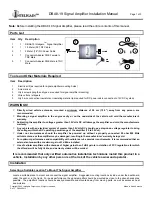
4
Mackie Industrial White Paper
Noise Sensing
September 2000
which signicantly reduced the adaptation amount when the
error was small, extending the adaptation time to well over 30
minutes. Our
beta
function
(patent pending)
gives stability to
the algorithm when the error is large, but effectively shortens
the adaptation time dramatically when the error becomes
small. This allows the algorithm to adapt to a room in only
a few minutes.
For small rooms a signicant portion of the music energy due
to the paths from speaker to microphone (including reec-
tions) are removed by the nLMS algorithm, as there would
have to be many reections before the sound could have trav-
eled this far. Each reection reduces the energy of the music
signal, and the amount of reduction of the energy is related
to the shape and material of the reecting surface. The more
‘live’ the room, the longer and more dense the RTF is, the
less the energy of the music signal that can be removed by the
nLMS lter [6]. Even without a lot of reections a very large
room may have poor cancellation due to the small number of
reections before the music signal has traveled the maximum
‘distance’ of the FIR.
Diagram 1: Matlab simulation Block Diagram and Results






























